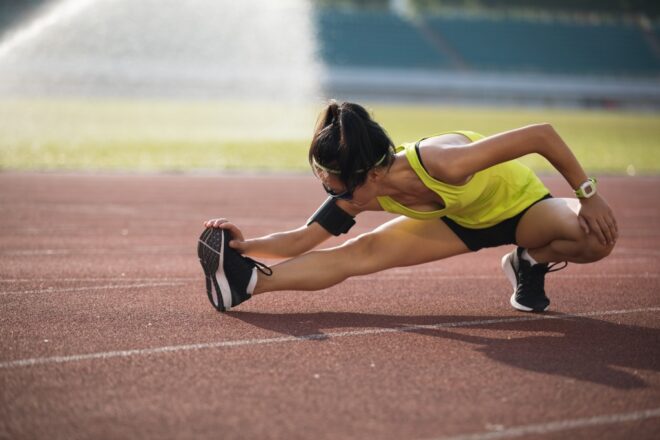In the high after a run, skipping post-run stretching is all too easy. Especially if you’re new to running and static stretching hasn’t become a routine.
But fast forward to the next day, and muscle soreness and decreased flexibility may make you regret skipping stretching. What’s more, you may run a higher risk of injury.
With proper stretching, you can avoid all that. You can reduce tightness in muscles, increase flexibility, and help your muscles cool down properly.
Whether you’re just building a running habit or already running every day, you want to stretch after running. Here’s what science has to say about static stretching and the best stretches for runners. We’ll also share tips on how to stretch correctly. Read on!
In This Article
In This Article:
Why Stretching After Running Matters
Post-run stretches are part of an effective cool-down that helps your body ease back into a relaxed state. When you stretch correctly after a run, you bring your heart rate down and increase blood flow to your muscles.
Stretching warm muscles can also speed up recovery while improving your range of motion. Altogether, stretching post-run can prevent injury for beginner runners.
Benefits of post-run stretches
Several scientific studies support the benefits of post-run stretches. To begin with, stretching frequently for at least 2 weeks increases a joint’s range of motion.
Interestingly, females gained a higher range of motion after stretching than males. A higher range of motion enables muscles to work at longer lengths, improving strength and possibly reducing the risk of injury.
Next, stretching may improve blood flow to your muscles. This doesn’t only deliver more oxygen to them but carries away waste produced during exercise back to the kidneys, such as uric acid or carbon dioxide.
Also, stretching for at least 30 seconds increases flexibility. Increased flexibility may improve running and athletic performance and help with everyday movements.
When you don’t stretch properly after a run, you may end up with tight muscles. More than feeling uncomfortable, tight muscles may limit your ability to move.
Static stretching also contributes to an effective running cool-down that regularizes your breathing, reduces your heart rate, and helps you relax.
It’s important to note that stretching after a run isn’t a cure-all for muscle soreness. A review of 12 studies found that stretching after exercise or at any other time doesn’t reduce muscle soreness.
How to Do Post-Run Stretches for Runners
To enjoy the benefits of post-run stretches, it’s important to perform them correctly. In addition to following proper stretching form, you have to stretch all the key muscle groups involved in running.
That includes doing a hamstring stretch, calf stretch, and more. Here are some of the best stretches for runners.
Hamstring stretches
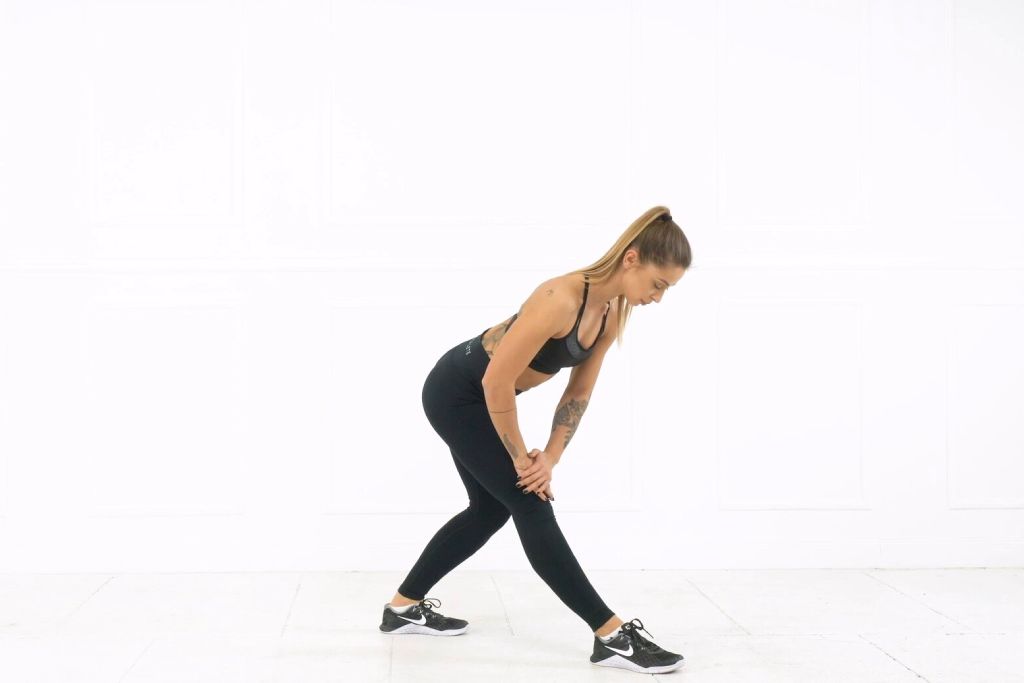
The hamstrings are a group of three muscles at the back of the thigh running from the hip to below the knee. The hamstrings bend your knees, extend your legs, and play a key role in running.
Although powerful, the hamstrings are susceptible to injury, which is why it’s important to stretch them. Stretching tight hamstrings post-run may help reduce the risk of muscle tears and strains.
1. Standing hamstring stretch
- Begin in an upright position with feet hip-width.
- Extend your right leg straight in front of you with the heel on the ground.
- Lean forward, hinging at the hips while keeping your back straight.
- Touch your toes with your fingers.
- Maintain the stretch for 30 seconds.
- Repeat with the other leg.
2. Seated hamstring stretch
- Lie on the floor with both legs stretched in front of you.
- Bend your right knee and place the sole of one foot against the inner left thigh.
- Reach out with your fingertips toward the toes of your left leg until you touch them.
- Maintain the stretch for 30 seconds.
- Repeat with the other leg.
3. Lying hamstring stretch
- Lie on your back with your legs straight.
- Keeping one leg straight, lift it off the ground.
- Bring your fingers together behind the thigh of the extended leg.
- Gently pull the leg toward your chest, feeling the stretch.
- Maintain the stretch for 30 seconds.
- Switch legs and repeat.
Quadriceps stretches

The quadriceps, or quads for short, are the largest muscle group in the body. Located at the front of your thigh, the quads perform a range of functions, including helping you get up from a chair, running, or squatting.
Stretching quads helps stimulate blood flow. Since they are large muscles, this may help them recover better after an intense run.
1. Standing quad stretch
- Begin in a standing position with feet hip-width. You may want to hold on to the back of a chair for balance.
- Bend your right knee and gently bring your heel toward your glute.
- Grasp the ankle of the bent foot with the right hand.
- Pull your foot closer to your glute and into a gentle thigh stretch and then into a deeper stretch.
- Maintain the stretch for 30 seconds.
- Change legs and repeat.
2. Lying quadriceps stretch
- Lie down on your left side, stacking your legs one over the other so that your right leg is on top.
- Bend your right knee and grab your right foot with your hand.
- Gently pull the right foot toward your glutes as you feel the stretch in your thigh.
- Maintain the stretch on your right side for 30 seconds.
- Adjust your position to lying on your right side.
- Repeat the movements with the left leg and left arm to stretch your left side.
3. Seated quadriceps stretch
- Sit on the edge of a chair with your legs extended in front of you.
- Bend your left knee and bring your heel toward your backside.
- Reach back with your left hand and grasp the left foot.
- Pull your foot closer to your glutes, feeling a light and then a deeper stretch.
- Maintain the stretch for 30 seconds.
- Repeat with the right foot.
Calf stretches
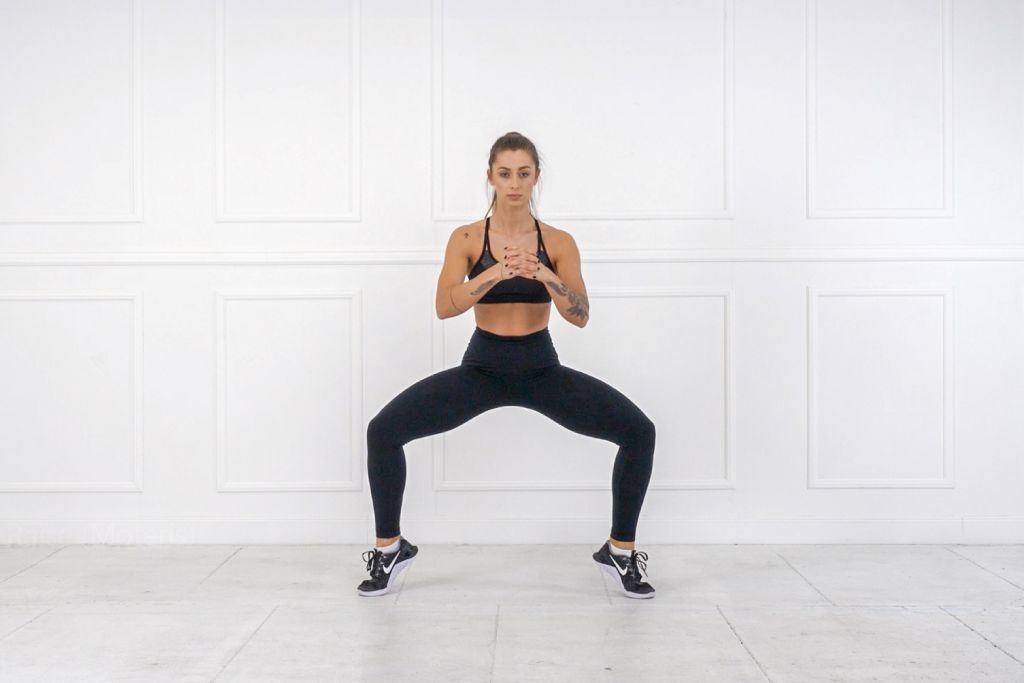
The main calf muscles are the gastrocnemius and the soleus. These muscles enable you to move your lower legs, flex your feet, run, and leap. Stretching your calves makes them more flexible and possibly reduces the risk of strains and other injuries.
Running is demanding on your calves, leading to tight calves and soreness while running. Stretching your calf muscles after a run may reduce feelings of tightness in them. Here are some of the best calf stretches for runners.
1. Wall calf stretch
- Stand tall before a wall with your hands on the wall at shoulder height.
- Step back with your right foot. Keep it flat on the ground.
- Lean toward the wall bending your left knee until you feel the stretch in your calf. Your right leg should remain straight.
- Maintain the stretch for 30 seconds.
- Step back with the left foot and repeat the movement with the opposite leg.
2. Standing calf stretch
- Stand before a wall with hands on it at shoulder height.
- Step back with the left foot.
- Lean forward, keeping both heels on the ground feeling the stretch in your calf. The back leg should remain straight.
- Hold for 30 seconds.
- Switch legs and repeat the steps above.
3. Downward dog calf stretch
- Begin in a high plank position, hands under your shoulders.
- Lift your heels back until your body is in an inverted V-shape, and you feel the stretch in your calf muscles.
- Hold the stretch for 30 seconds.
Hip flexor stretches

The hip flexors are a group of muscles that run along the front of your upper thigh. As their name suggests, these muscles flex the knee, bringing it closer to the chest. Without the muscles, you wouldn’t be able to take a step, let alone run.
Stretching these muscles after a run helps keep them loose. Done correctly, a hip flexor stretch prevents tightness and may aid recovery after a tough workout. For some of these stretches, you will need an exercise or yoga mat.
1. Kneeling hip flexor stretch
- Lower yourself to the mat and kneel on your right knee.
- Bend the left knee at a right angle, placing the foot flat on the ground before you.
- Activate your core and push your hips forward gently, feeling the stretch in your hip.
- Maintain the stretch for 30 seconds.
- Change legs and repeat.
2. Lunge with hip flexor stretch
- Place your right foot before you and the other back so that you’re in a lunge position.
- Bend your right knee at a right angle while keeping your left leg straight.
- Gently push your hips forward and keep your core engaged, feeling your hip muscles stretching.
- Maintain the stretch for 30 seconds.
- Repeat using the other leg.
3. Butterfly stretch
- Sit on the floor with your soles together.
- Let your knees fall out so that your legs form a diamond shape.
- Hold your ankles.
- Press your knees toward the ground gently.
- Hold the stretch in your hips for 30 seconds.
Glute stretches
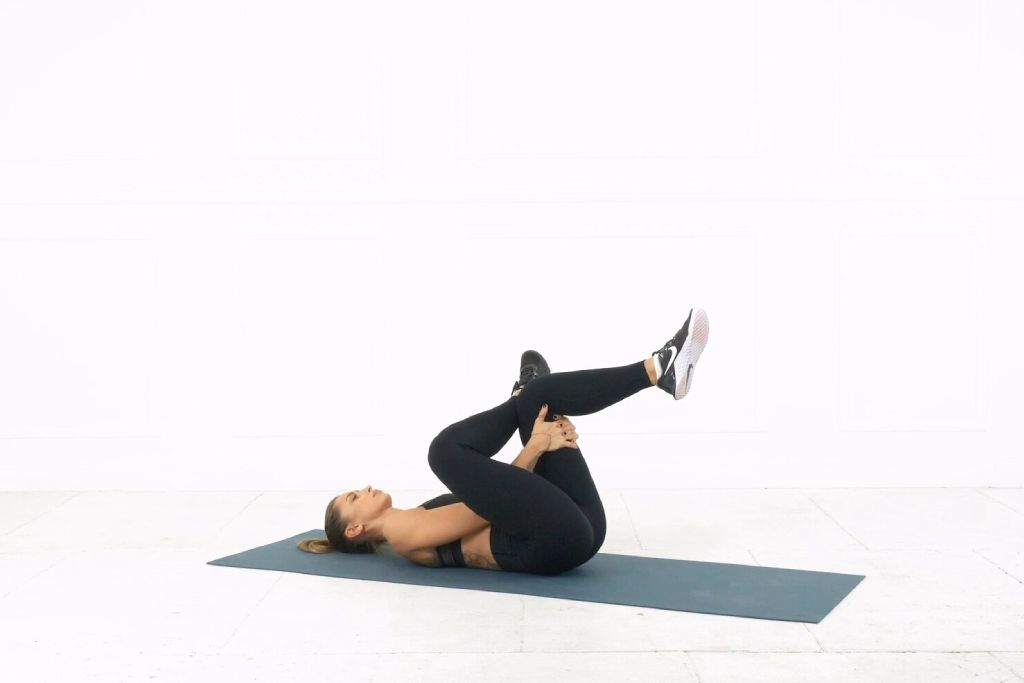
The glutes are a group of three muscles that make up the buttock. They are the gluteus maximus, gluteus medius, and gluteus minimus.
The glutes extend the hip, stabilize your upper body, and help with locomotion. When you run, the glutes generate running power, stabilize your pelvis, and control the lower leg.
1. Pigeon pose
- Begin in a high plank position.
- Bring your left knee forward until it’s angled diagonally behind your wrist.
- Extend your right leg behind you.
- Lower your upper body to the ground and rest on your forearms and hands.
- Maintain the stretch in your glutes for 30 seconds.
- Change legs and repeat.
2. Figure four stretch
- Lie on the floor with knees bent and feet flat.
- Bring your left ankle over your right knee into a figure-four shape.
- Clasp your hands behind your right thigh.
- Pull your right leg toward your chest.
- Feel the stretch in your left glute for 30 seconds.
- Switch to the right ankle and stretch the other side.
3. Seated glute stretch
- Sit on the edge of a chair with legs extended.
- Bend one knee.
- Cross the bent leg over the other leg.
- Place your foot flat on the ground.
- Rotate your torso toward the bent leg and press with the opposite elbow against the outside of the bent knee.
- Hold the stretch in your glute for 30 seconds.
- Change legs and repeat.
Doing Post-Run Stretches Properly
Just as running properly is important, so is stretching properly. To avoid injury and enjoy the benefits of stretching, you have to do post-run stretches correctly.
Follow the instructions for each stretch carefully. In addition, there are a few healthy stretching practices you need to pay attention to.
- Hold stretches for an adequate duration. Research suggests that you need to hold a stretch for 15–30 seconds to see results. Holding stretches beyond 30 seconds doesn’t appear to compound benefits and may even be detrimental.
- Focus on proper form. As with any form of training, you have to follow the proper form for the stretch to be effective and to reduce the risk of injury. You may have to practice a stretch you haven’t tried already before incorporating it into your training routine.
- Gradually increase the duration and number of stretches. If you’re new to exercising, you can start with 15-second stretches and gradually work your way to 30-second stretches. Start with one stretch per muscle group and gradually add more stretches to your routine.
- Breathe and relax into the stretches. Don’t hold your breath, as this may increase blood pressure and make you feel uncomfortable. Breathe in and out as you stretch.
Common Mistakes to Avoid When Stretching After a Run
Stretching appears to be very easy, which is why it’s easy to rush it or not follow the rules.
From not cooling down before stretching to holding your breath and not maintaining proper form, here are the key stretching mistakes you want to avoid.
Avoiding these errors can help you become a better runner who’s less likely to get sidelined by injury.
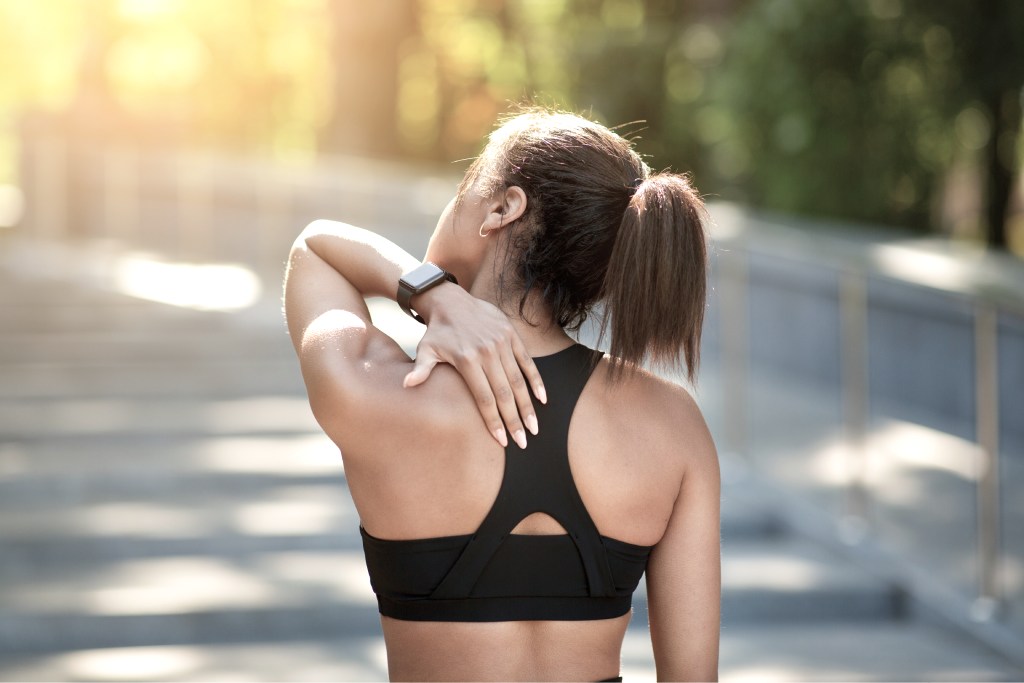
Skipping stretching altogether
First, the most obvious error – thinking that post-run stretches are useless and time-consuming. Stretching after running doesn’t magically reduce muscle soreness.
But as we’ve seen, a solid body of evidence shows that they can increase range of motion, flexibility and help you cool down.
Skipping stretching after a run can leave your muscles feeling uncomfortably tight and may increase the risk of strains and more serious injuries.
Not cooling down
Stretches for after running can be part of a cool-down. But they are not a substitute for a few minutes of slow jogging or easy walking.
An effective running cool-down normalizes breathing and heart rate and may help prevent muscle strains and tears. These can happen if you come to a sudden halt after running.
Bouncing or using jerky movements
Unlike dynamic stretches, post-run stretches are static. They require holding a specific position rather than following controlled movements.
While dynamic stretching can help your muscles warm up for exercise, static stretches release tightness in the muscles and help them cool down.
Pushing too hard, too fast
Don’t force a stretch into a sensation of discomfort, even if you feel tempted to go for that extra stretch. If you’re new to stretching, stick to doing lighter stretches and reducing the duration of a stretch.
Overstretching can result in strains, sprains, and other muscle injuries that can sideline you. Give yourself enough time to perform a good stretch slowly and with proper attention.
Ignoring key muscle groups
Common post-run stretches may stretch your hamstrings and quadriceps. But they may ignore calves, hip flexors, and glutes.
All of these muscles are involved in running. A well-rounded stretching routine ensures that all your leg muscles cool down properly.
Holding your breath or tensing up
Holding your breath during a post-run stretch reduces oxygen intake and may raise blood pressure. If you also tense up during a stretch, the result can be an uncomfortable sensation.
Breathe deeply in and out as you stretch. Stretch with gentle movements, letting go of the tension that has accumulated in your body.
Failing to maintain proper form and alignment
Static stretches are effective when you follow the correct form and body alignment. Rushing through them or doing them incorrectly may lead to injury.
Static stretches after a run are simple. But they still call for focus, attention, and a solid understanding of the postures and movements necessary to reach them.
FAQs
What stretches to do after running?
The best stretches to do after running include stretches that target all the major muscles involved in body motion and stability. These include stretches that target the hamstrings, quadriceps, calves, hip flexors, and glutes.
Effective stretches include standing hamstring and quad stretches, wall calf stretches, kneeling hip flexor stretches, and figure-four stretches.
Should you stretch straight after running?
Yes, you want to do after-run stretches as soon as you’ve completed your cool-down. While you need to stretch your legs after a workout without delay, make sure you cool down first with a few minutes of easy jogging.
Post-running stretches help you cool down but aren’t a complete cool-down in themselves.
How long can you wait to stretch after running?
Stretch immediately after your cool-down. Wait for as little as possible after your run before doing your first post-run stretch. The more time passes, the tighter your muscles will become.
That said, it’s still better to do stretches for runners for up to one hour after running than to skip stretching altogether.
Takeaways
When you stretch after running, you relieve muscle tension and ease your muscles into a more relaxed state.
Post-running stretches won’t magically eliminate muscle soreness. But they can improve flexibility and range of motion, and this can lead to better running performance.
Don’t skip a cool-down before stretching, and don’t rush stretches. Also, don’t stretch beyond a point of mild discomfort – a light stretch will do. Most importantly, stretch all your major lower leg muscles from the glutes and quads to the calves.
If you’re at the beginning of your running journey, Joggo can be a great companion for you. Joggo provides a personalized running plan according to your goals, including warm-up, cool-down, and the best stretches for running.
Joggo helps you get stretching right to maximize benefits. It also provides educational articles and smart tips and tricks that can help you in your running journey.
References:
- Kay, A.D., Rubley, B., Talbot, C., Mina, M., Baross, A.W. and Blazevich, A.J., 2018. Stretch imposed on active muscle elicits positive adaptations in strain risk factors and exercise‐induced muscle damage. Scandinavian journal of medicine & science in sports, 28(11), pp.2299-2309.
- Goheen, C., Pre-run Warm up and Post-run Recovery.
- Tallarico, M.Q., 2022. The Impact of Dynamic Stretching Duration on Running Performance and Mood (Doctoral dissertation, Ohio Dominican University).
- Linton, L. and Valentin, S., 2020. Running coaches and running group leaders’ engagement with, and beliefs and perceived barriers to prehabilitation and injury prevention strategies for runners. Physical Therapy in Sport, 46, pp.54-62.
- Nelson, A.G., Kokkonen, J., Eldredge, C., Cornwell, A. and Glickman‐Weiss, E., 2001. Chronic stretching and running economy. Scandinavian journal of medicine & science in sports, 11(5), pp.260-265.
- Shrier, I., 2004. Does stretching improve performance?: a systematic and critical review of the literature. Clinical Journal of sport medicine, 14(5), pp.267-273.

